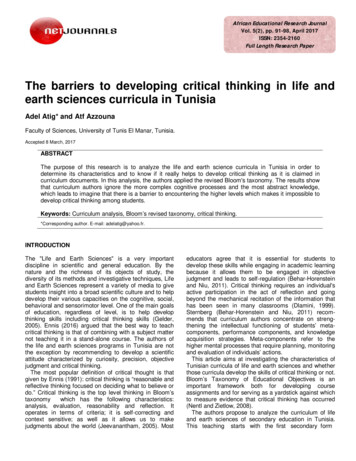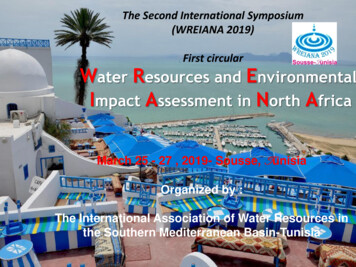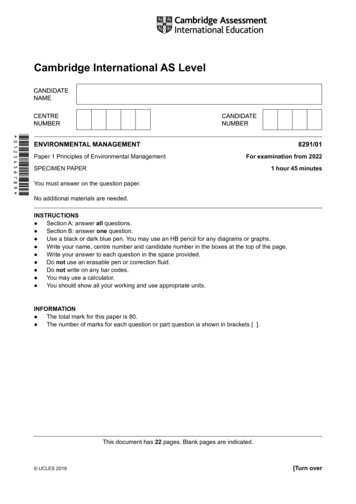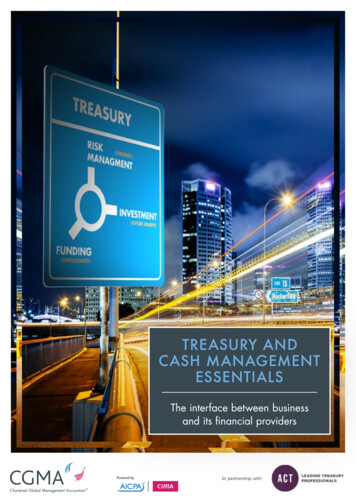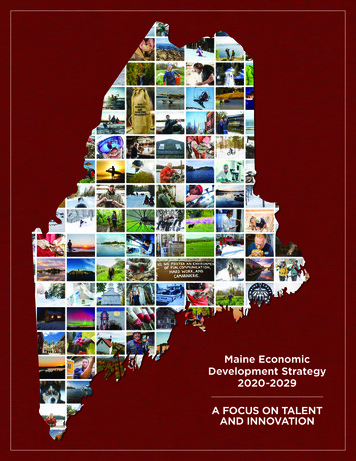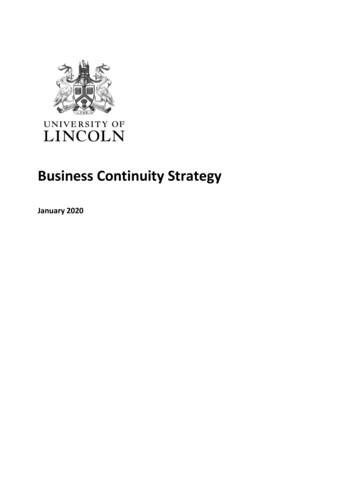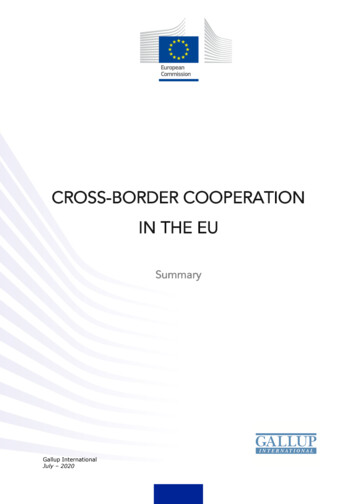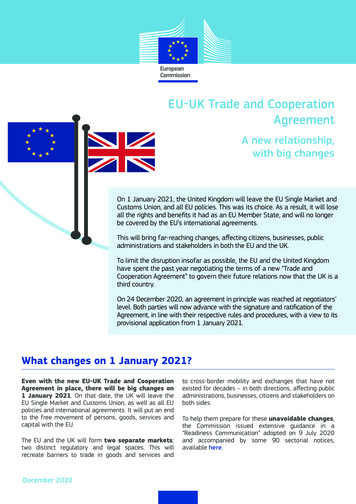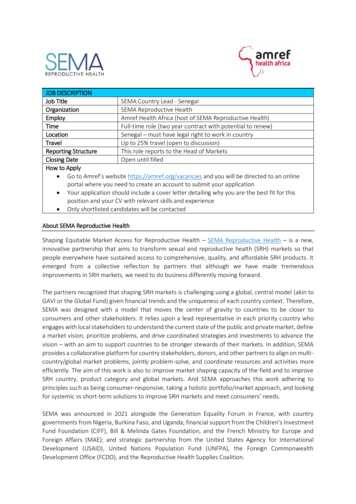
Transcription
Tunisia Country DevelopmentCooperation StrategySeptember 2016Photo: Young Tunisian entrepreneurs participate in skills building exercises as part of the Mashrou3iprogram jointly funded by USAID, UNIDO, Hewlett Packard, and the Government of Italy.For Public Distribution
For Public DistributionTable of ContentsAcronyms . iiiExecutive Summary . 1Development Context, Challenges, and Opportunities . 5Challenges . 5Opportunities . 6Government of Tunisia and U.S. Government Priorities . 7Evidence and Lessons Learned. 7USAID’s Comparative Advantage and Other Stakeholders. 9Local Systems . 10Sustainable Development Goals . 11Results Framework and Development Hypotheses . 13CDCS Goal: Inclusive Participation in Tunisia’s Socio-Economic Transformation Enabled. 13Nexus between Development Objectives . 14Development Objective 1: Inclusive Private Sector Employment Increased . 20Development Hypothesis . 20Critical Assumptions and Risks. 24Cross-Cutting Issues . 25IR 1.1: Private Sector Demand for Skilled Labor Increased . 26IR 1.2: Workforce Skills Better Matched to Market Needs . 28IR 1.3: Accountable Public Financial Management Systems Enhanced . 31Development Objective 2: Social Cohesion Promoted Through Democratic Consolidation . 34USAID/Tunisiai
For Public DistributionDevelopment Hypothesis . 34Critical Assumptions and Risks. 36Cross-Cutting Themes . 36IR 2.1: Accountable Governance Strengthened . 38Monitoring, Evaluation, and Learning . 44Monitoring . 44Evaluation . 46Collaboration, Learning, and Adapting (CLA) . 46Recommendations . 50Climate Change Considerations . 53USAID/Tunisiaii
For Public DistributionAcronymsADS - Automated Directives SystemAfDB - African Development BankARABOSAI - Arab Organization for Supreme Audit InstitutionsAU – African UnionAUP – African Union PartnershipBRCP - Business Reform and Competitiveness ProjectCDCS - Country Development Cooperation StrategyCLA - Collaborating, Learning, and AdaptingCSO - Civil Society OrganizationCVE - Countering Violent ExtremismDE - Developmental EvaluationDfID - United Kingdom Department for International DevelopmentDO - Development ObjectiveDRG - Democracy, Rights, and GovernanceDRL - Democracy, Rights, and LaborEU - European UnionG7 - Group of SevenGBV - Gender-Based ViolenceGCC - Global Climate ChangeGIZ - Deutsche Gesellschaft für Internationale ZusammenarbeitGDP - Gross Domestic ProductGOT - Government of TunisiaHIV - Human Immunodeficiency VirusICCM - International Counterterrorism and Countering Violent Extreme Capacity BuildingClearinghouse MechanismIFI - International Financial InstitutionIMF - International Monetary FundINS - l'Institut National de la Statistique de TunisieINTOSAI - International Organization for Supreme Audit InstitutionsIR - Intermediate ResultIRI - International Republican InstituteMCC - Millennium Challenge CorporationMEL - Monitoring, Evaluation, and LearningMENA - Middle East and North AfricaUSAID/Tunisiaiii
For Public DistributionMERP - Middle East Regional PlatformMEPI - Middle East Partnership InitiativeNDI - National Democratic InstituteNEET - Not in Education, Employment, or TrainingOECD - Organization for Economic Cooperation and DevelopmentOGP - Open Government PartnershipOTI - Office of Transition InitiativesPEA - Political Economy AnalysisPFM - Public Financial ManagementPMP - Performance Monitoring PlanSDG - Sustainable Development GoalSDP - Strategic Development PlanSME - Small- and Medium-Sized EnterprisesTAEF - Tunisian-American Enterprise FundTTI - Tunisia Transition InitiativeUN - United NationsUNIDO - United Nations Industrial Development OrganizationUSG - U.S. GovernmentVE - Violent ExtremismVEO - Violent Extremist OrganizationUSAID/Tunisiaiv
For Public DistributionExecutive SummaryTunisia and the United States have a strong and continuing partnership with the shared objectivesof furthering Tunisia’s democratization, strengthening the Tunisian economy, and improvingsecurity. This Country Development Cooperation Strategy (CDCS) embodies this spirit ofpartnership and local ownership.To become more open, inclusive, and socially integrated, Tunisia has identified the need tounleash its private sector and promote economic opportunities for all. Simultaneously, Tunisiaseeks broader and more inclusive participation in governance in order to guarantee improvedpublic sector accountability and service delivery.The development objectives outlined in this CDCS represent USAID’s contribution over the nextfive years toward helping Tunisia surmount its economic and social challenges, as identified inthe Government of Tunisia’s (GOT) proposed 2016-2020 Strategic Development Plan (SDP).As depicted graphically, USAID’s five-year strategy features two interlocking developmentobjectives (DOs) - “Inclusive Private Sector Employment Increased” (DO 1) and “SocialCohesion Promoted through Democratic Consolidation” (DO 2) - with cross-cutting themes ofyouth, gender, and geographic integration. These elements will contribute to the goal of thisCDCS, entitled “Inclusive Participation in Tunisia’s Socio-Economic Transformation Enabled.”CDCS Results FrameworkUSAID/Tunisia1
For Public DistributionDO 1 assumes that if the government can maintain its overall macroeconomic balance andimplement meaningful economic reforms that improve the business enabling environment,workforce skills, and public financial management systems, private sector firms will respond byincreasing investment, expanding their business activity, and hiring more workers. Higheremployment, in turn, will directly boost inclusion and enable much broader participation byincreasing Tunisian confidence and economic hope for the future. DO 1 is driven by the need topromote inclusive, private sector-led growth that will reduce unemployment and contribute toTunisia’s longer-term socio-economic transformation. Under Intermediate Result (IR) 1.1 (“Private Sector Demand for Skilled LaborIncreased”), USAID will continue working primarily at the firm level, mainly with smalland medium enterprises (SMEs) that have strong potential for expansion. This includessupport for improved marketing, management, human resources, and other systems thatpromote firm growth and job creation. Under Intermediate Result 1.2 (“Workforce Skills Better Matched to Market Needs”),USAID will work with training institutions, workers, and existing labor-matchingsystems to strengthen the links between Tunisia’s education system and its private sector(including associations and chambers of commerce). Activities under IR 1.3 (“Accountable Public Financial Management SystemsEnhanced”) will work with the Government of Tunisia to improve public financialmanagement in tax collection and administration, transparency and accountability ofpublic resources and budgets. As shown in the results framework, IR 1.3 ties directly tothe “Accountable Governance” of IR 2.1.DO 2 assumes that if Tunisia builds a more effective government that fosters collaborationbetween institutions and citizens while building community resilience, then improved socialcohesion will contribute to a more democratic and inclusive society. Activities will be designedto create tangible results and provide positive and sustainable development. Activities under IR 2.1 (“Accountable Governance Strengthened”) will support moreaccountable and inclusive governance through citizen participation, while supporting theGovernment of Tunisia to effectively address citizen needs. IR 2.2 (“Community Resilience Strengthened in Select Geographic Areas”) will focus ondelivering measurable impacts on populations in marginalized regions and addressingsome of the drivers of violent extremism.Gender, youth, and geographic integration are also critical considerations for promotinginclusiveness and social cohesion in Tunisia and will be factored into activities cutting acrossboth DOs and all five IRs.USAID/Tunisia2
For Public DistributionPartnership and Local SystemsUSAID will partner with Tunisian civil society and private sector actors, and support GOT-ledefforts to enable Tunisia’s socio-economic transformation. USAID will also collaborate withinternational partners. Working with Tunisian and international stakeholders to maximizedevelopment investments and results is critical to helping Tunisia advance its ambitiousdevelopment agenda.Adapting and LearningUSAID will take a deliberate and systematic approach to integrating monitoring, evaluation, andlearning over the life of the CDCS. This approach will include: Performance monitoring to ensure that programming is relevant to conditions on theground and that projects and activities support strategic objectives; Evaluations and analyses; Assessment of assumptions, risks, hypotheses and approaches; and Coordination with stakeholders, including the G7 EU-Tunisia Partners Group, topromote Tunisian leadership and sharing and application of new knowledge acrosssectors and international partner-funded programs. 11The G7 includes the United States, Canada, France, Germany, Italy, Japan, and the United Kingdom.USAID/Tunisia3
For Public DistributionTunisia Country DevelopmentCooperation StrategyUSAID/Tunisia4
For Public DistributionDevelopment Context, Challenges, and OpportunitiesTunisia and the United States have a strong and continuing partnership, with shared objectives offurthering Tunisia’s democratization, strengthening the Tunisian economy, and improvingsecurity. As a lower middle-income country with relatively developed economic institutionsand a democratically-elected government, Tunisia is an exception in a conflict-affected region.Despite the dramatic positive changes after the 2011 popular uprising, however, Tunisia stillsuffers from negative historical legacies that undermine its economic and political development.ChallengesTunisia’s development is hindered by a lack of inclusion and participation, with political andeconomic systems slowly shifting beyond serving a narrow, privileged segment of Tunisiansociety. High levels of unemployment and stagnant growth persist. Slow GDP growth in theEurozone, predicted to average about 1.7 percent through 2017, 2 is likely to limit demand forTunisian exports. Security issues also undermine the country’s economic growth potential,especially in the areas of tourism and foreign investment. For example, Tunisia’s Ministry ofTourism reported 70 percent fewer European visitors in 2015 compared to 2014, after widelypublicized attacks. 3 Climate risks related to natural resource management as well as the need formore robust and diversified economic activity in the south and interior compound these issues.Governing and economic power remains predominantly in the hands of a political and economicelite class concentrated on the coasts. Lack of cohesion at the central government level hurts thegovernment’s ability to design and implement effective development initiatives in marginalizedareas of the country. Efforts to address these challenges have fallen short of expectations,leading to disaffection, dissatisfaction, and undermining of the formal political processes. InJanuary 2016, Tunisia witnessed the largest wave of nationwide protests since January 2011. 4With stagnant economic growth, security challenges, and inadequate governance mechanisms tochannel frustrations, the situation in Tunisia is fragile.Tunisia’s youth, who although highly schooled, suffer from high unemployment rates andperceive themselves as being disenfranchised within the political system, as evidenced by theirlow turnout during elections in 2014. 5 Recent perception polling showed that 55 percent of2BBC, “Eurozone growth forecast cut to 1.7 percent,” February 4, 2016. urism-in-figures/figures-2015.html4New York Times, “Tunisia Sets Nation-Wide Curfew Amidst Growing Unrest,” January 22, eeast/tunisia-curfew-unemployment.html? r 05International Institute for Democracy and Electoral Assistance, “Social Cohesion and Democracy,” 2009.USAID/Tunisia5
For Public DistributionTunisians believe that the government is doing little to nothing to help youth. 6 Women also facebarriers to full social, economic, and political participation despite a legacy of state support forwomen’s rights. While current laws provide progressive protections, in reality, theimplementation of these laws is inconsistent. Tunisian women experience a high prevalence ofviolence, with initial data from a USAID-funded regional gender-based violence (GBV) activityshowing that 47 percent of Tunisian women have experienced at least one form of violence. 7Other marginalized communities, including gender and sexual minorities, experience routineeconomic and social discrimination.The threat of violent extremism (VE) is also concerning in Tunisia, with implications fornational and regional stability. Recruitment of Tunisian men and women into extremistorganizations, whether to operate in Tunisia or as foreign terrorist fighters, along with theinfiltration of these organizations into Tunisia pose additional threats to the success of Tunisia’seconomic and political transition.OpportunitiesThere are significant opportunities in economic growth, social transformation, and democraticconsolidation. Tunisia’s status as a lower middle-income country, along with its literatepopulation and proximity to Europe and other trading partners, points to opportunities foreconomic growth. Moreover, Tunisia benefits from relatively developed political and economicinstitutions that stand to benefit from the Government of Tunisia’s reform program, which seeksto increase their transparency, accountability, and efficiency. Passage of critical legislation such as the Bankruptcy Law and Banking Sector Law - will help attract additional domestic andinternational investment and will support accelerated private-sector-led economic growthopportunities. USAID’s support for expansion of private enterprises and continued work on keyfiscal reform issues may also help fuel additional economic growth opportunities.Tunisia’s constitution, passed in 2014, provides a path forward for democratic consolidation andultimately a more cohesive Tunisia. It reflects democratic principles, including a rights-basedapproach with protections for women and minorities, and enshrines youth participation as a keypillar of the social, economic, and political development of the country. To date, however, manyarticles of the Constitution are not yet implemented, resulting in legal and institutional gaps thatcontinue to undermine Tunisia’s social cohesion. Programming under the CDCS, therefore, willinclude interventions aimed at bolstering social cohesion and building political capital until theselegal and institutional gaps are closed.6International Republican Institute Center for Insights in Survey Research, “Public Opinion Survey of Tunisians:May 24-30, 2016,” 2016. http://www.iri.org/sites/default/files/wysiwyg/iri tunisia survey may 2016 public.pdf7USAID, Draft Tunisia Context Analysis from the Countering Gender Based Violence Initiative for MENA, March2016.USAID/Tunisia6
For Public DistributionThe GOT’s constitutionally-mandated commitment to decentralization represents anotherwindow of opportunity. Decentralization is a complex process and the GOT can benefit fromtechnical assistance. Within the CDCS timeframe, transparent decentralization initiatives thatfocus on demonstrable short-term performance improvements to foster accountability can go along way toward advancing Tunisia’s long-term socio-economic transformation.Finally, the strong partnership between the GOT and the U.S. government represents anotheropportunity for advancing Tunisia’s transition. The U.S.-Tunisia Strategic Dialogue process,which centers on expanding economic ties, security cooperation, democracy, scientific,educational, and cultural partnership, presents a constructive forum for stronger bilateralcooperation while keeping an emphasis on Tunisian-led development priorities and localownership.Government of Tunisia and U.S. Government PrioritiesThe GOT’s proposed Strategic Development Plan (SDP) 2016-2020 outlines five axes: 1)enhancing good governance, administrative reform, and anti-corruption; 2) accelerating theadoption of crucial reforms to develop a higher value-added economy; 3) developing humancapital and promoting social inclusion; 4) reducing regional disparities; and 5) embracing thegreen economy as a pillar of sustainable development. To support this plan, a Group of Seven(G7) European Union (EU)-Tunisia Partners Group was formed to improve coordination andsupport implementation of the proposed SDP. USAID, as part of the U.S. Embassy, is activelyparticipating in this group, and co-facilitates the “Human Development and Social Inclusion”thematic working group. USAID also participates in the groups for the other axes as they relateto the priorities identified under this CDCS.Evidence and Lessons LearnedThe CDCS was developed based on extensive research and analysis, as well as lessons learnedfrom previous implementation. In addition to drawing upon pre-existing analyses, such as the2011 Millennium Challenge Corporation (MCC)-African Development Bank (AfDB) TunisiaInclusive Growth Diagnostic, USAID also completed a gender analysis; a climate risk screening;a democracy, rights and governance assessment; and a mandatory Foreign Assistance Act 119Biodiversity report. These findings form a key part of the evidence-based foundation of theResults Framework and have been integrated throughout the strategy. Further, these analyseswill inform subsequent projects and activity designs in support of the CDCS Results Framework.USAID/Tunisia7
For Public DistributionUSAID graduated Tunisia fromassistance in 1994, but re-opened in2014, and since then, has focused largelyon economic growth. In addition tomacro-fiscal support in the form of acash transfer and sovereign loanguarantees, USAID established theTunisian American Enterprise Fund(TAEF) and is working to improveeconomic growth and governance as itprovides finance in the Tunisian market.USAID also has learned from its modestDRG programming, including supportfor elections as well as community-levelresilience. The CDCS reflects many ofthe lessons gained from these programs,including the need for continual learningand adaptive management throughoutthe strategy and project lifecycle.Economic Growth Lessons LearnedTunisia is a lower middle income country struggling to achieve its desired level ofeconomic growth, averaging less than three percent annually over the past decade. On a percapita basis, growth averaged less than two percent over the last decade. 8 Despite this, Tunisia isfortunate to have a functional institutional base and an educated population with the will, drive,and capacity to bring about change. Over the past few years of successful private sectoremployment programming, USAID has learned how to effectively work with existing privatesector enterprises poised for growth to provide focused, tailor-made assistance designed tounlock growth potential. USAID has learned that in Tunisia as elsewhere, small investments canlead to big impacts, and that linking private sector engagement with improving workforcetraining and targeted policy reform efforts is crucial to delivering meaningful, cost-effectiveresults. For example, private sector-led, adaptive programming provided through the BusinessReform Competitiveness Project (BRCP) produced more than 10,000 private sector jobs in twoyears thanks to its locally driven firm-level focus.Democracy, Rights, and Governance (DRG) Lessons LearnedUSAID has also learned important lessons from prior USG DRG programming in Tunisia,including the importance of identifying, and engaging with relevant local stakeholders. For8The World Bank reclassified Tunisia to the lower middle income category in 2015 based on stagnating grossnational income per capita.USAID/Tunisia8
For Public Distributionexample, USAID supported domestic election monitoring, including Tunisia’s first ever parallelvote tabulation, to increase transparency and Tunisian ownership of the 2014 election processes.USAID’s 2011-2014 Tunisia Transition Initiative (TTI), implemented by the Office of TransitionInitiatives (OTI), applied similar principles. TTI activities responded to emerging political issuesand focused on increasing civic engagement, building the capacity of civil society organizations,increasing the voice of marginalized groups, including youth and women, in political processes,fostering tolerance, and countering VE. TTI implemented a quick response framework to guidethe program in responding rapidly to the evolving political landscape, resulting in the followinggood practices: 1) narrowing the geographic focus to concentrate gains and increase impact; 2)focusing on key demographics, such as youth, to promote opportunities for decision-making andcommunity involvement; 3) empowering local staff in programmatic decision-making toarticulate clear, responsive, and flexible programming; 4) harnessing the power and reach ofsocial media; and 5) clustering and linking activities to achieve activity sub-objectives, inaddition to coupling one-time events with support to institutions, such as schools or youthcenters. These good practices have been complemented and furthered by other ongoing USGassistance, including grants managed by the Middle East Partnership Initiative (MEPI) and theDepartment of State’s Democracy, Rights, and Labor (DRL) bureau, focused on heighteninggovernment accountability, strengthening civil society, and promoting inclusive youth, gender,and regional participation.Taken together, lessons learned from the USG’s prior Tunisia programming highlight severalimportant themes: 1) building on existing Tunisian capacity and institutions; 2) strategicallyleveraging investments to maximize results; and 3) building flexibility into programming toadapt to a dynamic operating environment and seize new opportunities as they arise.USAID’s Comparative Advantage and Other StakeholdersNumerous multilateral organizations, bilateral agencies, and international financial institutions(IFIs) in Tunisia provide assistance and partnerships on different levels and in interrelatedsectors. Collaborating with Tunisian and international stakeholders is critical to helping USAIDto achieve the CDCS results.USAID’s Comparative AdvantageUSAID’s previous success in implementing private sector-led employment qualifies it tocontinue such efforts, consistent with international approaches coordinated through G7 EUTunisia Partner Groups. USAID has also identified specific programming gaps - such asbuilding effective and responsive local governance systems, and building community resilience that are not being sufficiently addressed but are critical to advancing GOT-identified priorities.For example, USAID activities under DO 2, IR 2.1 will complement broader decentralizationefforts being led by the World Bank and half-a-dozen other international partners. CommunityUSAID/Tunisia9
For Public Distributionresilience activities under DO 2, IR 2.2 will complement other international partner-ledcommunity initiatives.International Partner Coordination and MappingUSAID meets regularly with the international community in Tunisia to discuss ways tocollaborate and leverage opportunities. For example, USAID is a participant in regularinternational partner meetings on the topics of decentralization, local governance, andemployment. The G7 EU-Tunisia Partners Group aims to improve international partnercoordination and support implementation of the SDP. Under the G7 EU-TunisiaPartners Group,the USG co-chairs a thematic working group on Human Development and Social Inclusion.In preparation for the CDCS, USAID conducted its own initial international partner mapping andconsulted mapping efforts carried out by EU, the World Bank, DFID, and the Italiangovernment. The G7 EU-Tunisia Partners Group conducted a similar mapping exercisecollaboratively with the GOT, which USAID supported. Broad themes exist. Internationalfinancial institutions are focused on high-level economic reform and infrastructure initiatives,while the G7, other bilateral international partners, the EU and the United Nations are focused onimproving private sector employment and social safety nets while supporting the democratictransition. USAID will continue international partner mapping related to this CDCS, as needed.Local SystemsUSAID’s Local Systems Framework builds on principles of aid effectiveness and sustainabilitythat have developed over years of USAID’s operations around the world. In order to improvelong-term sustainability of development outcomes, the CDCS embraces the Local SystemsFramework’s ten core principles and integrates many of them directly into its strategicframework. For example, the CDCS focus on engaging local systems, embracing flexibility, andmonitoring and evaluating for sustainability are all core Local Systems principles. In addition,the Local Systems Framework calls for improving understanding of the local context by mappinglocal systems. The CDCS consultation process started this work, but USAID also intends toconduct a limited political economy analysis to further map these systems. The CDCS emphasison inclusion - specifically for women, youth, and people living in geographically marginalizedareas - reflects the Local Systems belief that “a country system should be framed inclusively.” 9Country Transition PlanUSAID’s role in Tunisia must support the long-term sustainability of development outcomes asdefined by the Tunisian people. USAID recognizes that the overall goal of its assistance is toenable a Tunisian-led and owned inclusive socio-economic transformation. This CDCS9USAID, “Local Systems: A Framework for Supporting Sustained Development,” April ameworkUSAID/Tunisia10
For Public Distributionrepresents USAID’s re-engagement with Tunisia at a critical moment in the consolidation of itsdemocratic reforms.The CDCS will help address core issues facing Tunisia, such as bolstering economic growth andhelping consolidate Tunisia’s democratic institutions. Nevertheless, addressing these challengesrequires more nuanced, adaptive, and flexible development planning, and USAID fullyanticipates the need for programming beyond 2020.As the relationship evolves, USAID’s role will gradually shift to more policy assistance. DO 1,with its economic growth focus, has the most immediate potential for transition. Initialprogramming will directly help create jobs by working with individual firms, but over thelonger-term, as job creation reaches necessary levels, USAID’s efforts to support policy reformsand promote stability will naturally transition into more focused policy assistance. USAID firmlevel assistance will also transition to advisory assistance commercially available from theprivate sector. Such assistance will be coordinated with USAID’s efforts, over the next fiveyears, to increase private sector engagemen
workforce skills, and public financial management systems, private sector firms will respond by increasing investment, expanding their business activity, and hiring more workers. Higher employment, in turn, will directly boost inclusion and enable much broader participation by increasing Tunisian confidence and economic hope for the future.
